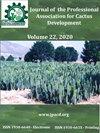Quality of fermented cactus pear (Opuntia spp.) and its effect on liveweight gain of Dorper lambs
IF 0.4
4区 农林科学
Q4 HORTICULTURE
Journal of the Professional Association for Cactus Development
Pub Date : 2020-06-20
DOI:10.56890/jpacd.v21i.7
引用次数: 2
Abstract
The high-water (85%) and low protein (5%) content of cactus cladodes (Opuntia spp.) reduce the amount of dry-matter consumed by ruminants. The objective of this study was to use protein enrichment technology to increase Opuntia protein content and to feed Dorper lambs, comparing the Opuntia protein enrichment and the basal diet in the liveweight gain. The experiment was carried out for 60 days, using a biodigester (100 kg of cactus) -Title No. 2641- IMPI. The process was based on the daily aerobic semisolid fermentation of Opuntia by applying yeast of the Sacharomyces cereviceae (1%) type, urea (1%) and ammonium sulfate (0.1%) during 20 h (1 h of movement and 1.5 h of rest) recycling the yeast for a week. Unfermented Opuntia cladodes were used as the control. The enriched Opuntia was provided in the final stage in two treatments in a completely randomized design with three replications: 1) Basal diet (control), and 2) Basal diet + fermented fresh Opuntia. The liveweight of each animal was recorded weekly. Analysis of variance and comparison of means were performed (Tukey HSD p=0.05 and orthogonal contrasts p?0.05). The results of the fermentation showed that fermented Opuntia significantly (p?0.01) decrease carbohydrates content (48.9 to 26.4%); increased crude protein content (5.64 to 33.17%) and energy (2.26 to 2.67 Mcal kg-1) compared with unfermented Opuntia. However, on the seventh day of fermentation, these values decreased significantly, because of the temperature decrease. At the end of the experiment, the live-weight increased significantly 11.62 ± 0.99 kg animal-1 month-1 in groups of four lambs fed with enriched Opuntia, while the liveweight of animals fed with the basal diet only increased 8.42 ± 1.69 kg animal-1 month-1, showing a difference in the liveweight gain of 800 g lamb-1 week-1 fed with fermented Opuntia cladodes.发酵仙人掌梨品质及其对杜泊羔羊活增重的影响
仙人掌的高水分(85%)和低蛋白质(5%)含量减少了反刍动物消耗的干物质量。本研究的目的是利用蛋白质富集技术提高赤羊的蛋白质含量,并饲喂杜泊羔羊,比较赤羊蛋白质富集与基础饲粮在活重增重方面的差异。试验进行了60天,使用生物消化器(100公斤仙人掌)-标题号2641- IMPI。该工艺以每天好氧半固态发酵为基础,采用Sacharomyces cereviceae(1%)型酵母,尿素(1%)和硫酸铵(0.1%),发酵20 h(运动1 h,休息1.5 h),循环发酵一周。以未发酵的枝机会菌为对照。最后阶段采用完全随机设计,分2个处理,3个重复:1)基础饲粮(对照)和2)基础饲粮+发酵鲜牛蒡。每周记录每只动物的活重。进行方差分析和均数比较(Tukey HSD p=0.05,正交对比p=0.05)。发酵结果表明,发酵后的青霉显著(p?0.01)降低了碳水化合物含量(48.9% ~ 26.4%);粗蛋白质含量(5.64 ~ 33.17%)和能量(2.26 ~ 2.67 Mcal kg-1)均高于未发酵的黑麦。然而,在发酵的第7天,由于温度的降低,这些值明显下降。试验结束时,4组添加丰富的机会子组羔羊的活重显著增加了11.62±0.99 kg -1个月1,而基础饲粮只增加了8.42±1.69 kg -1个月1,与添加发酵机会子的800 g羔羊-1周1的活重增加量存在差异。
本文章由计算机程序翻译,如有差异,请以英文原文为准。
求助全文
约1分钟内获得全文
求助全文
来源期刊

Journal of the Professional Association for Cactus Development
Agricultural and Biological Sciences-Plant Science
CiteScore
1.10
自引率
33.30%
发文量
10
期刊介绍:
The editors of the Journal of the Professional Association for Cactus Development, are very excited to be a part of the excellent editorial committee and to work together to create the synergism between scientists, growers, legislators, and business people so vital to the development of this industry to serve the people of arid lands.
 求助内容:
求助内容: 应助结果提醒方式:
应助结果提醒方式:


